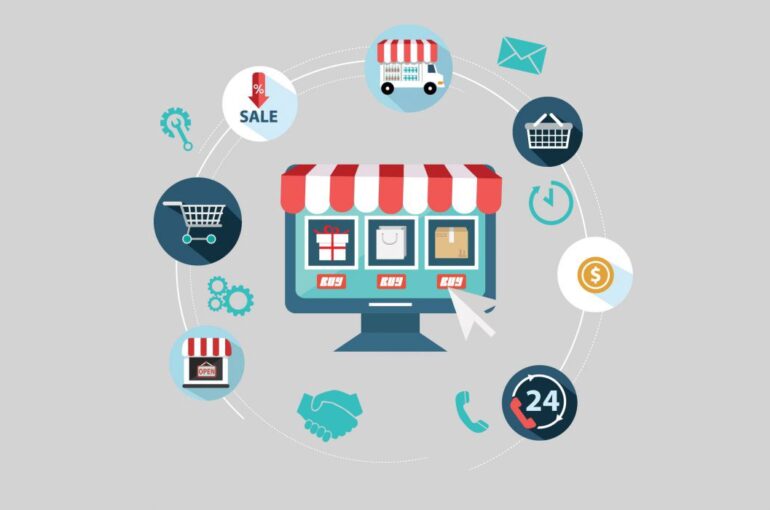What if we told you that there’s something that can boost the sales of your ecommerce business as well as reinforce your client base. We don’t mean some kind of magic. The recipe is simple but at the same time super-effective.
We’re talking aboutapps. To be precise, we mean shopping apps.To be even more precise, it’s about ecommerce apps.
According to the statistics which you’ve just seen, for 2020, the number of smartphone users is forecast to reach 2.87 billion. As you can see, the number of mobile users is constantly growing.
Sooner or later, mobile devices may outstrip desktops as the main devices for online retail. For this very reason, not making a mobile app for your ecommerce, may be a big mistake.
Nevertheless, before you start developing your masterpiece, you need to be aware of some key features, which are must-need in every ecommerce app. Below, we prepared a list of the crucial features that are necessary when building an ecommerce app.
The Power of Visual Content
Do you remember a typical physical store with all the products organized and displayed in a way to attract the users’ attention? There’s a certain art to making the users choose your product. And this aspect is even more important when it comes to ecommerce apps.
There’s only one step between buying and abandoning a product. To help people make the right choice, you need something to hook them with. In this case, it may be any item displayed on your online store.
Take pictures of each of the product (keep in mind that they need to look impeccable). Show them from different angles, this will create a three-dimensional understanding of the project. When you do shopping in a physical shop, you can touch the product, except just looking at them. Such a luxury is not available (so far) in the digital world.
Nevertheless, you can create comfortable conditions for people by using a visual side.
It takes only 0.25 seconds to process non-verbal, visual content. Some sources even suggest that visual information is processed 60,000 times faster than text! Now you feel the power of visual content? The images communicate your brand as well as your product. So make sure that your value is well communicated through your images.
User Experience Personalization
An indispensable component of a successful mobile ecommerce app is personalization. When made a strong personalization, you create the impression that every element is in its place, everything is convenient and works perfectly. There are several ways of personalizing the UX of your app. Let’s take a look at some of them:
Breadcrumbs
Breadcrumbs is a highly popular strategy in ecommerce mobile app. They help users browse products, navigate an application’s hierarchy efficiently, and easily return to a previous product list or the main application menu. This feature also allows for getting rid of illogical jumps, while searching for the products as well as preventing customers from getting stuck on pages. Additionally, this helps reducing the bounce rate by keeping users in the application as long as possible.
There are several types of breadcrumbs:
- Attribute-based. This should help a user identify an important quality or attribute of the content or page being viewed.
- Location-based in order to help a user identify their current location in the site structure.
When we talk about using breadcrumbs in mobile apps, we need to take our mobile screen space seriously. In order not to overload it, find a compromise. Provide users with at least one step back. This will serve both as a browsing tool and a hit of where they’re at.
Instead of a long and disturbing form, such as “Click here in order to go back and see more items,” you can make it shorter, and just add a simple “See more items.”
Wish List Button
In no case should this feature be neglected. Around the world, millions of customers are wandering on the ecommerce shops looking for the product they want. In most of the cases, they don’t have an immediate intent to buy something at once. So they click on an item they like to return to it in the near future. Such items go to the wish list collection.
Wishlist is like an anchor, which keeps customers between purchasing and forgetting. This is a great option when you’re not ready to order something but want to remember a product or shop until later. Besides, wish lists can become a motivation for customers to sign up an account. In the long view, they may be involved in the marketing campaigns if they sign up to receive email notifications.
By adding a wish list button into your mobile app, you create an effective solution for getting rid of shopping cart abandonment as well as fulfilling sales from customers who showed intent but didn’t make a purchase.
Make The Registration Process Simple
Nowadays, it’s the time when the technology works for the user. Everything should be simple and user-friendly. Having a long and difficult registration process won’t benefit your business at all. In case, your app demands too much information, sooner or later your users will lose their interest.
The majority of consumers are not happy with filling out long registration forms or being forced social login to sign up. There’s a huge amount of apps that request a lot of information up to get you registered.
You shouldn’t repeat the mistakes of apps with poor UX. For example, here’s an example of how Amazon does it.
As you can see, everything looks simple, starting from sign up to checkout. Besides, a mobile app takes the user directly to the main page so that a user doesn’t have to fill in a registration form until checkout.
The Thumb-Friendly Zone
Over 70% of mobile users use their right thumb to click the screen. Mobile users give their smartphones specific commands that look like a variety of touch inputs and commands. Usually, all these commands are being given with a single hand.
The UI designs should be made in such a way to allow users to comfortably navigate a website as well as an app single-handedly. The opening of the apps, as well as unlocking and locking of screens, require a tap, double-tap, pinch or zoom on the screen.
That’s why the single-handed use of mobile devices requires thumb-friendly gesture controls. When neglecting this factor, the mobile experience may become non-engaging.
The Bottom Line
With the growth of the eCommerce business, it became quite difficult to develop a competitive app that is capable of attracting the users’ attention. Nevertheless, we believe that the tips listed in this post can help your app break out from the pack.
Undoubtedly, there are other useful features that may positively contribute to the UX of your app. However, it’s impossible to touch all the buttons.
Most importantly, is that an eCommerce mobile app should provide a unique and immersive experience, which can make the shopping process as simple and seamless as possible. Additionally, it should include features, which drive sales and bring more revenues to your business.
Power Technologies – For further enquiries on any of our expertise or services, whether it is for website design & development, mobile application development, or digital media marketing, please feel free to contact or WhatsApp (+6016)-202 1700, email [email protected] or visit powertechnologies.com.my. Thank you.

